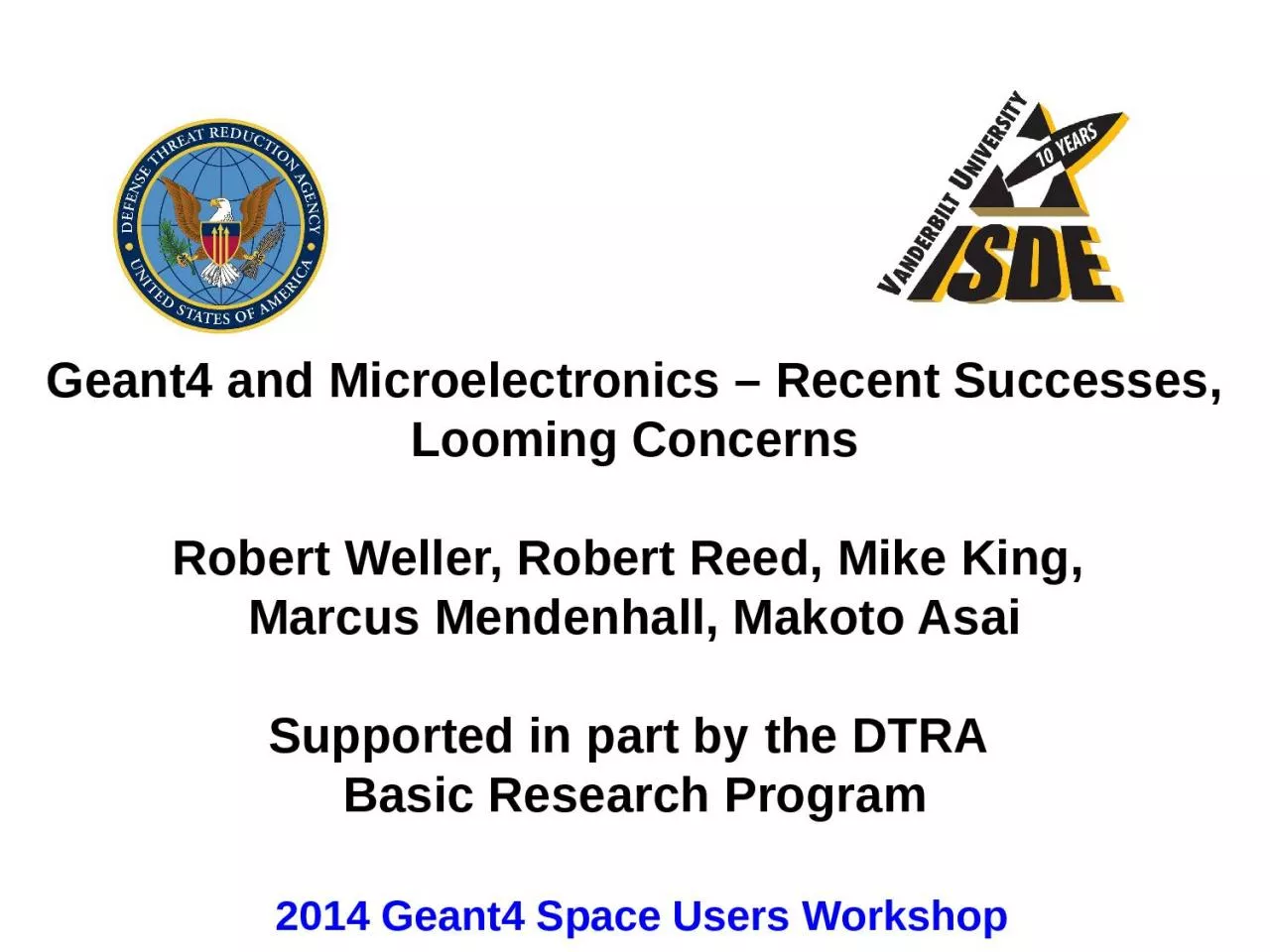

Robert Weller Robert Reed Mike King Marcus Mendenhall Makoto Asai Supported in part by the DTRA Basic Research Program 2014 Geant4 Space Users Workshop Energetic ElectronInduced ID: 931189
Download Presentation The PPT/PDF document "Geant 4 and Microelectronics – Recent ..." is the property of its rightful owner. Permission is granted to download and print the materials on this web site for personal, non-commercial use only, and to display it on your personal computer provided you do not modify the materials and that you retain all copyright notices contained in the materials. By downloading content from our website, you accept the terms of this agreement.
Slide1
Geant4 and Microelectronics – Recent Successes, Looming ConcernsRobert Weller, Robert Reed, Mike King, Marcus Mendenhall, Makoto AsaiSupported in part by the DTRA Basic Research Program 2014 Geant4 Space Users Workshop
Slide2Energetic Electron-Induced Single-Event Upsets in SRAMs
Slide3Energetic electron
creates e-h pairs
Particle Strikes Sensitive
Node of SRAM
Circuit Transient Response
Results in Error
Single Electron-Induced SEU
Slide4Increasing Sensitivity of SRAMs
65 45 32 22 16
Slide5Motivation For Electron-Induce SEU
Critical
charge estimates for 22 nm on the order of 0.1
fC
– 0.35
fC
at nominal supply voltage
Devices are becoming increasingly sensitive to lightly ionizing particles
Low-energy Protons
Muons
MRED simulations suggested
electrons can deposit energy in excess of critical charge
estimates
- 2.6
keV or 0.12fC
10
keV
electron
50 nm
Cube
Slide6Experimental Method #1 – X-ray Irradiation
28 nm and 45 nm SRAMs
X
-rays used to generate secondary energetic electrons
Dose rate of 100 rad(SiO
2
)/
min
Reduced bias testing
Devices were designed and verified experimentally to be functional at all supply voltages used in this experiment
Incident
X-ray
Energetic Electron
Sensitive
Volume
Slide7Upsets in 28 & 45 nm SRAMs
SEU probability
Eliminated TID, photocurrents, and functionality as source of observed errors
No significant parametric degradation; power supply current stable
Slide8Experimental Method #2 – Electron Irradiation
Arnold Engineering Development Center
Space Threat Assessment
Testbed
(STAT
)
Electrons
, protons, photons, and others
AEDC
Slide9Electron-Induced SEUs
28 nm
SRAMs
100
keV
and 40
keV
electrons
Flux = 2.6 × 10
7
cm
-2
s
-1
Fluence
= 1 × 1010 to 5 × 1010
cm
-
2
Reduced bias testing
Condition
SEU Probability
Standard
Error
0.45 V, 100
keV
1.71E-07
1.19E-08
0.5 V, 100
keV
5.04E-08
7.06E-09
0.45 V, 40
keV
3.13E-07
2.55E-08
Slide10Experimental Method #3 – Sr-90 electron sourceThe Use of Strontium-90 Beta Radiotherapy as Adjuvant Treatment for Conjunctival MelanomaCohen VM, Papastefanou
VP, Liu S, Stoker I, Hungerford JL - J Oncol (2013
Slide11Potential Space Environments
Solar
activity (solar flares, CMEs, solar wind, photons)
Trapped
particle Environment (Earth, Jupiter, etc..)
Bremsstrahlung
produce by primary environment interactions with S/C
Beta
decay in packaging
Activated
nuclei in S/C
Local delta-rays (generated by heavy-ions)
Shower produced by high-energy (~
TeV
)
ions interacting with S/C
Slide12Conclusions
Provided evidence of single electron-induced SEU in 28 nm and 45 nm technologies
Electron-induced SEU primarily a concern for low-power applications, may impact more sensitive current generation ICs at nominal supply
voltage
Modeling
of
electron transport down to very low energies may be an important issue for future technology
Need to identify
critical space radiation environments
Slide13Cubesat Program Update
Slide14Goal: Provide a low cost on-orbit system to improve our understanding of the impact of space radiation environments on satellite components and systemsOne system delivered for S/C integration One slated for summer 2014 deliveryAnother TBD experiment schedule for early 2016Satellite Program OverviewWarren - Cubesat14
Slide15Vanderbilt provides payloadCubeSat partner provides spacecraft busRadFxSat ConceptExample PayloadExample Spacecraft
Warren - Cubesat15
Slide16Senior Design Teams2012 teamDesigned an latchup experiment that will be flown on the RadFx-1 2013 teamPreliminary design of an SRAM tester2014 team Evaluated commercial CubeSat S/C for radiation effects
16